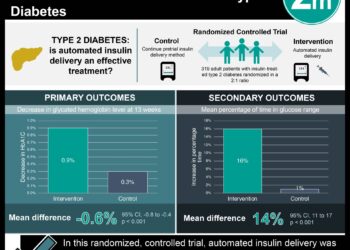Prevalence of type II diabetes on the rise since 1980s
1. In this study, a significant increase in the prevalence of diabetes was noted across every gender, age group, racial/ethnic group, education level, and income level.
2. This study found that when adjusted for age, diabetes was more common among non-Hispanic black, non-Hispanic Asian, and Hispanic individuals than it was among non-Hispanic white individuals.
Evidence Rating Level: 2 (Good)
Study Rundown: Type II diabetes is a chronic condition that affects the way our bodies metabolize glucose. Genetic and environmental factors such as weight and physical inactivity both contribute to one’s predisposition. Excess glucose results in the numerous complications of diabetes including neuropathies, retinopathy, and heart disease. This study aimed to estimate the prevalence and update the national trends of diabetes in US adults. In order to do so, the authors of this study analyzed data from the National Health and Nutrition Examination Survey (NHANES) and compared data from various cohorts from 1988 to 2012.
This study noted a significant increase in the prevalence of diabetes across every gender, age group, racial/ethnic group, education level, and income level when comparing data from 1988-1994 with that from 2011-2012. The study is strengthened by its use of NHANES data, which measures a large sample population with a strict study protocol. Limitations were due to the self-reported nature of measuring previous diabetes as well as possible diabetes misclassification in some groups. While measures to increase physical activity, control children’s diets, and increase health insurance coverage have been making headway, these findings demonstrate that continued efforts will be required for the country to manage this condition.
Click to read the study in JAMA
Click to read the accompanying editorial in JAMA
Relevant Reading: Prevalence and Incidence Trends for Diagnosed Diabetes Among Adults Aged 20 to 79 Years, United States, 1980-2012
In-Depth [cross-sectional study]: This study evaluated data collected in the 1988-1994 and the 1999-2000 to 2011-2012 NHANES. Data from 23 634 adults between 1988-2010 was used to measure trends and from 2,781 adults between 2011-2012 to measure prevalence. Compared with non-Hispanic white participants (11.3%; 95%CI 9.0%-14.1%), the age-standardized prevalence of diabetes in the 2011-2012 group was higher in non-Hispanic black participants (21.8%; 95%CI 17.7%-26.7%]; p < 0.001), non-Hispanic Asian participants (20.6%; 95%CI 15.0%-27.6%; p = 0.007), and Hispanic participants (22.6%; 95%CI 18.4%-27.5%; p < 0.001). A significant increase in the prevalence of diabetes was noted across every gender, age group, racial/ethnic group, education level, and income level, with an overall increase in prevalence from 9.8% (95%CI 8.9-10.6) in 1988-1994 to 12.4% (95%CI 10.8-14.2) with a p 0<0.001.
Image: PD
©2015 2 Minute Medicine, Inc. All rights reserved. No works may be reproduced without expressed written consent from 2 Minute Medicine, Inc. Inquire about licensing here. No article should be construed as medical advice and is not intended as such by the authors or by 2 Minute Medicine, Inc.







